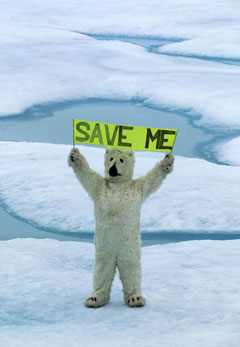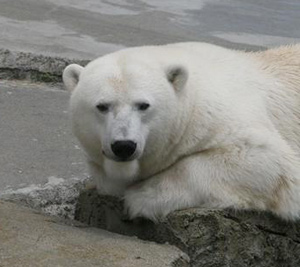Endangered species status of the polar bear to be decided May 15
Endangered species status of the polar bear to be decided May 15
mongabay.com
April 29, 2008
|
|
A federal judge has ordered the Bush administration to stop delaying its decision on whether to list the polar bear as an endangered species. Environmentalists say the bear is threatened by melting sea ice in its Arctic habitat.
Judge Claudia Wilken of the U.S. District Court for the Northern District of California ruled Monday that the Department of the Interior has violated the law by missing the deadline for filing a decision on the status of the polar bear by four months. She said the agency would have to arrive at a decision by May 15, 2008.
The Department of the Interior had sought to delay the decision until June 30, 2008. It had already missed a January 2008 deadline.
In March, the Center for Biological Diversity, the Natural Resources Defense Council, Greenpeace filed a complaint asking the court to end the delays. On Monday, Wilken ruled that “timeliness is essential” and “the issues are not complex.”
 Photo courtesy of Greenpeace |
“Defendants [Interior Secretary Dirk Kempthorne and the Fish and Wildlife Service] offer no specific facts that would justify the existing delay, much less further delay,” the decision states. “To allow Defendants more time would violate the mandated listing deadlines under the ESA and congressional intent that time is of the essence in listing threatened species.”
Environmentalists cheered the ruling.
“Today’s decision is a huge victory for the polar bear,” said Kassie Siegel, climate program director at the Center for Biological Diversity and lead author of the 2005 petition seeking the Endangered Species Act listing. “By May 15th the polar bear should receive the protections it deserves under the Endangered Species Act, which is the first step toward saving the polar bear and the entire Arctic ecosystem from global warming.”
“We have won in the court of public opinion and of law,” said Melanie Duchin, Greenpeace global warming campaigner in Alaska. “We hope that this decision marks the end of the Bush administration’s delays and denial so that immediate action may be taken to protect polar bears from extinction.”
Scientists say the polar bear is at risk due to melting sea ice resulting from global warming. In September, biologists with the U.S. Geological Survey warned that the United States and Russia will likely lose all of their polar bear populations due to thinning and disappearing sea ice by 2050. The loss would amount to around two-thirds of the world’s population of the species.
 Photo by R. Butler |
Declining sea ice is a major threat to polar bears, which are currently being considered for protection under the Endangered Species Act. A November 2006 study published by scientists from the U.S. Geological Survey and the Canadian Wildlife Service, revealed a 22 percent decline in the size of the western Hudson Bay polar bear population between 1987 and 2004. The research also found that only 43 percent of polar bear cubs in the surveyed area survived their first year, compared to a 65 percent survival rate in the late 1980s and early 1990s. Meanwhile in September 2006, Ian Stirling, a research scientist with the Canadian Wildlife Service, reported that the average weight of adult female polar bears in western Hudson Bay has fallen from 650 pounds in 1980 to just 507 pounds in 2004.
Other reports indicate that drowned polar bears are being found for the first time in Alaska. Researchers speculate that greater distances between ice sheets could be taking a toll on the bears. While bears are capable of swimming long distances–up to 60 miles (100 km) without stopping–it is conceivable that they could suffer from exhaustion during an unexpectedly arduous swim. A shorter spring hunting season caused by progressively earlier breakup of sea ice, reduces the chances of reproductive success for female polar bears.
The loss of ice also makes it more difficult for bears to find food. Unlike grizzly bears, polar bears aren’t adapted to hunting land animals like caribou, instead feeding primarily on seals. However, recent aerial surveys by the U.S. Fish and Wildlife Service show that over the past five years, polar bears are changing their habits and spending more time on land, congregating on beaches and scavenging whale carcasses. Accordingly, a USGS study published in July reported that polar bears in Alaska are increasingly setting up dens on land because sea ice is thinning. Using satellite telemetry to track the den-making habits of bears in northern Alaska, the scientists found the proportion of dens on ice compared with land fell from 62 percent in the 1985-1994 period to 37 percent between 1998 and 2004. The researchers say that declining quality sea ice makes ice less stable to mothers to raise their cubs. In recent years Arctic sea ice has been forming later and melting earlier, leaving it thinner.
USGS, which issued reports on three of 19 distinct subpopulations of polar bear, did not estimate precisely how many polar bear would remain 50 years from now. Scientists estimate there are currently 20,000 to 25,000 polar bears world-wide.
Environmentalists say while the outlook for polar bears and other Arctic and Antarctic species — including walrus and 12 species of penguin — is dire, it is not took late to protect wildlife threatened by climate change.